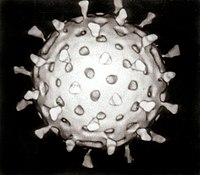
Photo from wikipedia
Abstract Norovirus is a prominent enteric virus responsible for severe acute gastroenteritis disease burden worldwide. In our current study, we analyzed 7,804 norovirus sequences of human and animals in China… Click to show full abstract
Abstract Norovirus is a prominent enteric virus responsible for severe acute gastroenteritis disease burden worldwide. In our current study, we analyzed 7,804 norovirus sequences of human and animals in China which were detected from 1980 to 2020 from GenBank. The GenBank database was searched up to May 2021 with the following search terms: “norovirus” or “norwalk virus” and “China.” The 7,804 norovirus sequences were collected and evaluated by phylogenetic analysis using MEGA X software package. The online typing tool (https://www.rivm.nl/mpf/typingtool/norovirus/) was used to confirm the genotypes. There were 36 norovirus genotypes prevailing in China. GII.4 was the most prevalent genotype, and GII.2, GII.3 and GII.17 also emerged during different time periods. Most sequences were detected in East China (41.72%, 3,256/7,804), but different norovirus genotypes were distributed widely across the country. A variety of norovirus genotypes, including GI, GII, GIII, GIV, GV, GVI, GVII and GX, were reported in different animals. Furthermore, a GI.3 sequence detected from animal had high identity with norovirus detected in human from the same region, indicating the potential norovirus zoonotic transmission in China. In conclusion, these results indicated that norovirus sequences with considerable genetic diversity distributed widely in China, with potential reverse zoonotic transmission from human to animals.
Journal Title: Open Life Sciences
Year Published: 2022
Link to full text (if available)
Share on Social Media: Sign Up to like & get
recommendations!